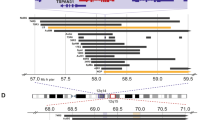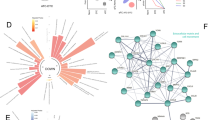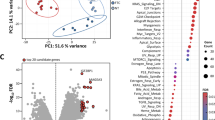Abstract
Anaplastic thyroid cancer (ATC) is one of the most lethal of all human tumors, but cytogenetic information concerning ATC is extremely limited. Using our in-house array-based comparative genomic hybridization and 14 ATC cell lines with further fluorescence in situ hybridization analysis, we demonstrated amplification of the DUSP26 gene, known by another report as MAP kinase phosphatase-8. DUSP26 was overexpressed in ATC cell lines and primary ATC tumor samples. When overexpressed, either exogenously or endogenously, DUSP26 promoted growth of the ATC cells. DUSP26 encodes a protein containing a dual-specificity phosphatase domain that can dephosphorylate itself. DUSP26 effectively dephosphorylates p38 and has a little effect on extracellular signal-regulated kinase in ATC cells. DUSP26 protein formed a physical complex with p38, and promoted survival of ATC cells by inhibiting p38-mediated apoptosis. Our findings suggest that DUSP26 may act as an oncogene in ATC, and might be a useful diagnostic marker and therapeutic target of this disease.
This is a preview of subscription content, access via your institution
Access options
Subscribe to this journal
Receive 50 print issues and online access
$259.00 per year
only $5.18 per issue
Buy this article
- Purchase on Springer Link
- Instant access to full article PDF
Prices may be subject to local taxes which are calculated during checkout






Similar content being viewed by others
Accession codes
References
Bishop JM . (1991). Molecular themes in oncogenesis. Cell 64: 235–248.
Bulavin DV, Higashimoto Y, Popoff IJ, Gaarde WA, Basrur V, Potapova O et al. (2001). Initiation of a G2/M checkpoint after ultraviolet radiation requires p38 kinase. Nature 411: 102–107.
Bulavin DV, Demidov ON, Saito S, Kauraniemi P, Phillips C, Amundson SA et al. (2002). Amplification of PPM1D in human tumors abrogates p53 tumor-suppressor activity. Nat Genet 31: 210–215.
Bulavin DV, Fornace AJ . (2004a). P38 MAP kinase's emerging role as a tumor suppressor. Adv Cancer Res 92: 95–118.
Bulavin DV, Phillips C, Nannenga B, Timofeev O, Donehower LA, Anderson CW et al. (2004b). Inactivation of the Wip 1 phosphatase inhibits mammary tumorigenesis through p38 MAPK-mediated activation of the p16Ink4a-p19Arf pathway. Nat Genet 36: 343–350.
Carnero A, Hudson JD, Price CM, Beach DH . (2002). p16INK4A and p19ARF act in overlapping pathways in cellular immortalization. Nat Cell Biol 2: 148–155.
Campisi J . (1996). Relative senescence: an old lives' tale? Cell 84: 497–500.
Casanovas O, Miró F, Estanyol JM, Itarte E, Agell N, Bachs O . (2000). Osmotic stress regulates the stability of cyclin D1 in a p38SAPK2-dependent manner. J Biol Chem 275: 35091–35097.
Chang L, Karin M . (2001). Mammalian MAP kinase signaling cascades. Nature 410: 37–40.
Dixon D, Moyana T, King MJ . (1998). Elevated expression of the cdc25A protein phosphatase in colon cancer. Exp Cell Res 240: 236–243.
Garcia MJ, Pole J, Chin SF, Teschendorff A, Naderi A, Ozdag H et al. (2005). A 1-Mb minimal amplicon at 8p11–12 in breast cancer identifies new candidate oncogenes. Oncogene 24: 5235–5245.
Hoornaert I, Marynen P, Goris J, Sciot R, Baens M . (2003). MAPK phosphatase DUSP16/MKP-7, a candidate tumor suppressor for chromosome region 12p12–13, reduces BCR-ABL-induced transformation. Oncogene 22: 7728–7736.
Hu Y, Mivechi NF . (2006). Association and regulation of heat shock transcription factor 4b with both extracellular signal-regulated kinase mitogen-activated protein kinase and dual-specificity tyrosine phosphatase DUSP26. Mol Cell Biol 26: 3282–3294.
Inazawa J, Inoue J, Imoto I . (2004). Comparative genomic hybridization (CGH)-arrays pave the way for identification of novel cancer-related genes. Cancer Sci 95: 559–563.
Imoto I, Yuki Y, Sonoda I, Ito T, Shimada Y, Imamura M et al. (2003). Identification of ZASC1, encoding a Kruppel-like zinc finger protein, as a novel target for 3q26 amplification in esophageal squamous cell carcinomas. Cancer Res 63: 5691–5696.
Izumi H, Inoue J, Yokoi S, Hosoda H, Shibata T, Sunamori M et al. (2005). Frequent silencing of DBC1 is by genetic or epigenetic mechanisms in non-small cell lung cancers. Hum Mol Genet 14: 997–1007.
Juretic N, Santibanez JF, Hurtado C, Martinez J . (2001). ERK 1,2 and p38 pathways are involved in the proliferative stimuli mediated by urokinase in osteoblastic SaOS-2 cell line. J Cell Biochem 83: 92–98.
Liu B, Fang M, Lu Y, Lu Y, Mills GB, Fan Z . (2001). Involvement of JNK-mediated pathway in EGF-mediated protection against paclitaxel-induced apoptosis in SiHa human cervical cancer cells. Br J Cancer 85: 303–311.
McMullen ME, Bryant PW, Glembotski CC, Vincent PA, Pumiglia KM . (2005). Activation of p38 has opposing effects on the proliferation and migration of endothelial cells. J Biol Chem 280: 20995–21003.
Ohtani N, Zebedee Z, Huot TJ, Stinson JA, Sugimoto M, Ohashi Y et al. (2001). Opposing effects of Ets and Id proteins on p16INK4a expression during cellular senescence. Nature 409: 1067–1070.
Onda M, Emi M, Yoshida A, Miyamoto S, Akaishi J, Asaka et al. (2004). Comprehensive gene expression profiling of anaplastic thyroid cancers with cDNA microarray of 25344 Genes. Endocr Relat Cancer 11: 843–854.
Ono K, Han J . (2000). The p38 signal transduction pathway activation and function. Cell Signalling 12: 1–13.
Park JM, Greten FR, Li ZW, Karin M . (2002). Macrophage apoptosis by anthrax lethal factor through p38 MAP kinase inhibition. Science 297: 2048–2051.
Passler C, Scheuba C, Prager G, Kaserer K, Flores JA, Vierhapper H et al. (1999). Anaplastic (undifferentiated) thyroid carcinoma (ATC): a retrospective analysis. Langenbecks Arch Surg 384: 284–293.
Ray ME, Yang ZQ, Albertson D, Kleer CG, Washburn JG, Macoska JA et al. (2004). Genomic and expression analysis of the 8p11–12 amplicon in human breast cancer cell lines. Cancer Res 64: 40–47.
Sherman SI . (2003). Thyroid carcinoma. Lancet 361: 501–511.
Simon R, Richter J, Wagner U, Fijan A, Bruderer J, Schmid U et al. (2001). High-throughput tissue microarray analysis of 3p25 (RAF1) and 8p12 (FGFR1) copy number alterations in urinary bladder cancer. Cancer Res 61: 4514–4519.
Snijders AM, Schmidt BL, Fridlyand J, Dekker N, Pinkel D, Jordan RC et al. (2005). Rare amplicons implicate frequent deregulation of cell fate specification pathways in oral squamous cell carcinoma. Oncogene 24: 4232–4242.
Srikanth S, Franklin CC, Duke RC, Kraft AS . (1999). Human DU145 prostate cancer cells overexpressing mitogen-activated protein kinase phosphatase-1 are resistant to Fas ligand-induced mitochondrial perturbations and cellular apoptosis. Mol Cell Biochem 199: 169–178.
Takada H, Imoto I, Tsuda H, Nakanishi Y, Ichikura T, Mochizuki H et al. (2005). ADAM23, a possible tumor suppressor gene, is frequently silenced in gastric cancers by homozygous deletion or aberrant promoter hypermethylation. Oncogene 24: 8051–8060.
Takekawa M, Adachi M, Nakahata A, Nakayama I, Itoh F, Tsukuda H et al. (2000). p53-inducible wip1 phosphatase mediates a negative feedback regulation of p38 MAPK-p53 signaling in response to UV radiation. EMBO J 19: 6517–6526.
Tanoue T, Yamamoto T, Maeda R, Nishida E . (2001). A novel MAPK phosphatase MKP-7 acts preferentially on JNK/SAPK and p38 alpha and beta MAPKs. J Biol Chem 276: 26629–26639.
Theillet C, Adelaide J, Louason G, Bonnet-Dorion F, Jacquemier J, Adnane J et al. (1993). FGFR1 and PLAT genes and DNA amplification at 8p12 in breast and ovarian cancers. Genes Chromosomes Cancer 7: 219–226.
Tonon G, Wong KK, Maulik G, Brennan C, Feng B, Zhang Y et al. (2005). High-resolution genomic profiles of human lung cancer. Proc Natl Acad Sci USA 102: 9625–9630.
Vasudevan SA, Skoko J, Wang K, Burlingame SM, Patel PN, Lazo JS et al. (2005). MKP-8, a novel MAPK phosphatase that inhibits p38 kinase. Biochem Biophys Res Commun 330: 511–518.
Wada T, Penninger JM . (2004). Mitogen-activated protein kinases in apoptosis regulation. Oncogene 23: 2838–2849.
Walentinsson A, Helou K, Wallenius V, Hedrich HJ, Szpirer C, Levan G . (2001). Independent amplification of two gene clusters on chromosome 4 in rat endometrial cancer: identification and molecular characterization. Cancer Res 22: 8263–8273.
Wang W, Chen JX, Liao R, Deng Q, Zhou JJ, Huang S et al. (2002). Sequential activation of the MEK-extracellular signal-regulated kinase and MKK3/6-p38 mitogen-activated protein kinase pathways mediates oncogenic ras-induced premature senescence. Mol Cell Biol 22: 3389–3403.
Weinberg RA . (1995). The molecular basis of oncogenes and tumor suppressor genes. Ann NY Acad Sci 758: 331–338.
Widmann C, Gibson S, Jarpe MB, Johnson GL . (1999). Mitogen-activated protein kinase: conservation of a three kinase module from yeast to human. Physiol Rev 79: 143–180.
Wiseman SM, Loree TR, Rigual NR, Hicks WL, Douglas WG, Anderson GR et al. (2003). Anaplastic transformation of thyroid cancer: review of clinical, pathologic, and molecular evidence provides new insights into disease biology and future therapy. Head Neck 25: 662–670.
Wu JJ, Bennett AM . (2005). Essential role for mitogen-activated protein (MAP) kinase phosphatase-1 in stress-responsive MAP kinase and cell survival signaling. J Biol Chem 280: 16461–16466.
Wu W, Chaudhuri S, Brickley DR, Pang D, Karrison T, Conzen SD . (2004). Microarray analysis reveals glucocorticoid-regulated survival genes that are associated with inhibition of apoptosis in breast epithelial cells. Cancer Res 64: 1757–1764.
Yosimichi G, Nakanishi T, Nishida T, Hattori T, Takano-Yamamoto T, Takigawa M . (2001). CTGF/Hcs24 induces chondrocyte differentiation through a p38 mitogen-activated protein kinase (p38MAPK), and proliferation through a p44/42 MAPK/extracellular-signal regulated kinase (ERK). Eur J Biochem 268: 6058–6065.
Yu W, Inoue J, Imoto I, Matsuo Y, Karpas A, Inazawa J . (2003). GPC5 is a possible target for the 13q31–q32 amplification detected in lymphoma cell lines. J Hum Genet 48: 331–335.
Acknowledgements
We are grateful to Professor Y Nakamura (Human Genome Center, Institute of Medical Science, The University of Tokyo) for continual encouragement throughout this work. This work was supported by grants-in-aid for Scientific Research (to J Inazawa, I Imoto) and Scientific Research on Priority Areas (C) (to J Inazawa, I Imoto), and a 21st Century Center of Excellence (COE) Program for Molecular Destruction and Reconstruction of Tooth and Bone (to J Inazawa, W Yu) from the Ministry of Education, Culture, Sports, Science and Technology, Japan; and a grant from Core Research for Evolutional Science and Technology (CREST) of Japan Science and Technology Corporation (JST) (to J Inazawa). W Yu is a Heiwa Nakajima Foundation Scholar.
Author information
Authors and Affiliations
Corresponding author
Rights and permissions
About this article
Cite this article
Yu, W., Imoto, I., Inoue, J. et al. A novel amplification target, DUSP26, promotes anaplastic thyroid cancer cell growth by inhibiting p38 MAPK activity. Oncogene 26, 1178–1187 (2007). https://doi.org/10.1038/sj.onc.1209899
Received:
Revised:
Accepted:
Published:
Issue Date:
DOI: https://doi.org/10.1038/sj.onc.1209899
Keywords
This article is cited by
-
Dusp26 phosphatase regulates mitochondrial respiration and oxidative stress and protects neuronal cell death
Cellular and Molecular Life Sciences (2022)
-
Upregulation of dual-specificity phosphatase-26 is required for transforming growth factor β1(TGFβ1)-induced Epithelial-mesenchymal transition in A549 and PANC1 cells
Molecular Biology Reports (2022)
-
NEAP/DUSP26 suppresses receptor tyrosine kinases and regulates neuronal development in zebrafish
Scientific Reports (2017)
-
Comprehensive protein tyrosine phosphatase mRNA profiling identifies new regulators in the progression of glioma
Acta Neuropathologica Communications (2016)
-
Fimbriatols A–J, Highly Oxidized ent-Kaurane Diterpenoids from Traditional Chinese Plant Flickingeria fimbriata (B1.) Hawkes
Scientific Reports (2016)



